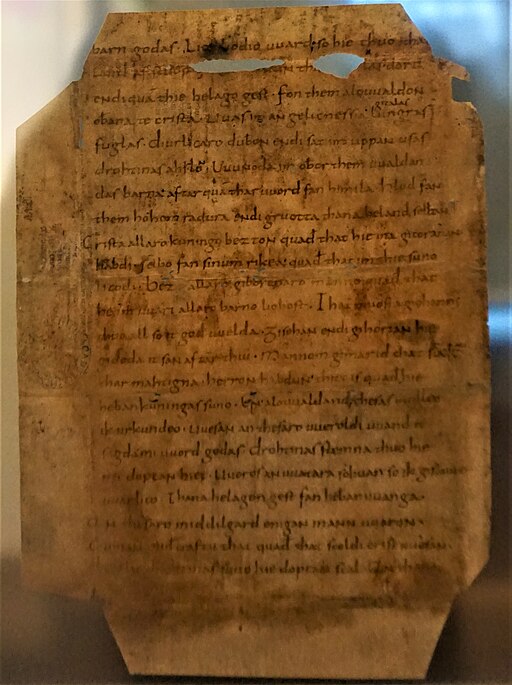
This is a fragment of the Heliand (Fragment P) from 830 AD, written as an epic poem in the Old Saxon language, depicting the life of Christ in a familiar way for the German people.
The Heliand was written at the request of the Emperor to combat Saxon ambivalence toward Christianity.
The Saxons were forced to convert to Christianity in the late 8th to early 9th century after 33 years of conflict between the Saxons and the Franks under Charlemagne.
The Heliand created a cultural synthesis between Christianity and Germanic warrior society.
The poem is a Biblical paraphrase that recounts the life of Jesus in the alliterative verse style of a Germanic epic. Christ is presented as the hero who does not enter Jerusalem, but rather a castle.
This approach to the narrative of Christ made it more relevant to the then prevailing German culture. The Heliand was in Old Saxon, and the title means savior in Old Saxon.
Heliand is the most extensive known work of written Old Saxon, but the identity of the author is uncertain, and there is a scholarly debate about the authorship.
The poem must have been relatively popular and widespread because it exists in two manuscript versions and four fragmentary versions. It takes up about 6,000 lines.
It was first printed in 1562, and while it has no authority in the scriptures, it is generally deemed to be authentic to 9th century Germany.
“Then he spoke and said there would come a wise king,
magnificent and mighty, to this middle realm;
he would be of the best birth; he said that he would be the Son of God,
he said that he would rule this world,
earth and sky, always and forevermore.”
– from the Heliand
Fragment of the Heliand
- Title: Fragment of the Heliand (Facsimile, Original Eigentum des DHM)
- Date: 830
- Origins: Germany
- Material: Parchment, handwritten
- Category: Ancient Texts
- Museum: Deutsches Historisches Museum
The Saxon Heliand
A Reading of The Heliand (The Saxon Gospel)
Virtual Tour of Ancient Texts
- Gilgamesh Flood Tablet – 7th century BC
- Lament for Ur – 1800 BC
- Law Code of Hammurabi – 1754 BC
- Complaint Tablet To Ea-nasir – 1750 BC
- Egyptian–Hittite Peace Treaty – 1259 BC
- Book of the Dead – Papyrus of Ani and Hunefe – 1250 BC
- Cyrus Cylinder – 539–538 BC
- The Rosetta Stone – 196 BC
- Constitution of the Athenians by Aristotle – 100
- Vindolanda Tablets – 1st-century
- Codex Vaticanus – 300–325
- Vienna Dioscurides – Juliana Anicia Codex – 515
- Lindisfarne Gospels – 715-720
- Fragment of the Heliand, The Saxon and Viking Bible – 830
- Beowulf – Nowell Codex – 975–1025
- Blue Qur’an – 9th – 10th century
- Miroslav Gospel – 1186
- Magna Carta – 1215
- Hadith Bayad wa Riyad – 13th-century
- The Belles Heures of Jean of France, Duke of Berry – 1405
Berlin Museums
-
- The Pergamon Museum
- Neues Museum
- Altes Museum
- Alte Nationalgalerie – National Gallery (Berlin)
- Bode Museum
- Gemäldegalerie, Berlin
- Spy Museum Berlin
- Jewish Museum, Berlin
- Deutsches Historisches Museum – German Historical Museum
- DDR Museum
~~~
“We can only see a short distance ahead, but we can see plenty there that needs to be done.”
-Georg Wilhelm Friedrich Hegel
~~~
Photo Credit: JOM
Popular this Week








 Sponsor your Favorite Page
Sponsor your Favorite Page SEARCH Search for: Search Follow UsJoin – The JOM Membership Program
Sponsor a Masterpiece with YOUR NAME CHOICE for $5
Share this:
- Tweet
